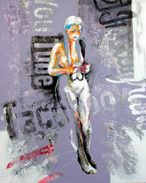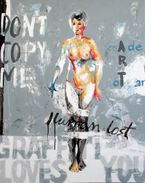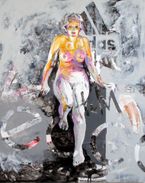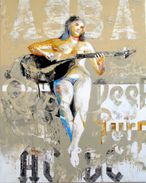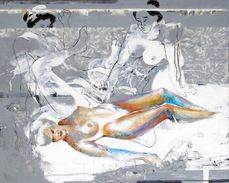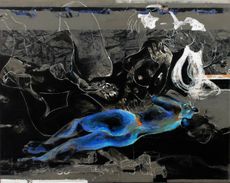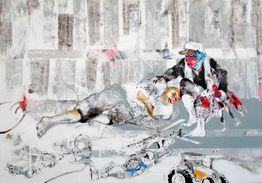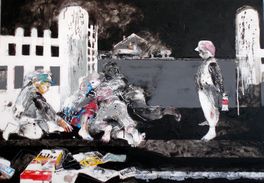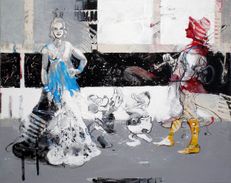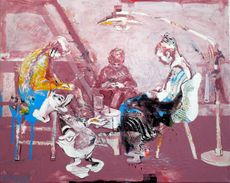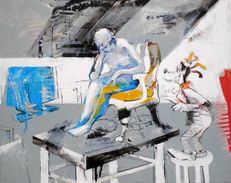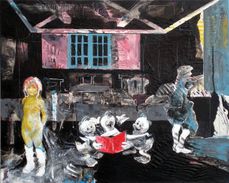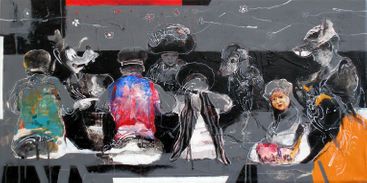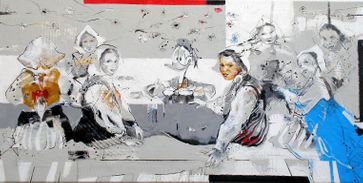Time to Meet the Masters - SWEDISH - Paraphrase images
SWEDICH CHAPS
Janusz Tyrpak is inspired by the Nordic painters of the turn of the century. The spectator can discern some influences from such painters as August Malmström, Anders Zorn and Carl Larsson. At the same time one can find elements from the era of pop art and posters of the 70s in his paintings. As a result of the anachronistic events within every painting - the language of icons is being questioned with tender humour.
Something that sets Tyrpak apart from the classic and romantic Nordic painters is, among other things, undoubtedly the choice of colours, as well as his approach to details. A monochrome palette is present in his work of art, exchanging the naturalistic details of his predecessors. The surroundings in Tyrpak`s paintings are rather a contemplation of an almost abstract landscape where structures and textures leave the spectator with a lot of space for personal interpretations. We either experience fear or fascination with this freedom of reading (his) art, which highly reflects the spirit of today. Most probably we experience both extremes the longer we challenge ourselves with our observations.
Meanwhile, the well-balanced and minimalistic palette that Tyrpak is using, along with the evocative layers of each painting, immediately involves the spectator and invites him to make continuously new discoveries. These, largely monochromatic oeuvres contain a limited amount of coloured spots, which attract our attention. Parts of the paintings seem to be set in the shadow while simultaneously they pertain sharp contours; all of which gives us the impression that what we see is set in several layers at the same time.
This duality of the paintings is emphasized by the thematic structure - where modern times meet the past; the pop culture is transcended back in time or put forward. The meeting of different eras, styles and worldviews is captured in the moment of a face-to-face encounter. On top of this, the painting techniques used by Tyrpak may recall memories from different stages of the development of photography. What I refer to is the use of black and white, various scales of sepia, as well as coloured photos which are found in the early works of photography. Photographic references can be traced both in terms of style and motives welcoming the spectator into an intimate artistic conversation. Tyrpak has found his own artistic language responding to the dilemmas of the present, where concepts of time and space are not necessarily perceived as linear any longer.
Tyrpak´s paintings appear to be witnessing their own process of coming to existence. As mentioned earlier, crafting various layers of every single painting tends to bring on the sense of every painting being amid the process of creation. With this being said, it does not imply that the paintings are not completed. On the contrary, Tyrpak’s works are expressions of a clear and personal unity while constantly being in motion; both with respect to the theme and the form, and the craftsmanship of the paintings. Every painting presents an individual spectrum of textures, many of which overlap one another, transforming into one another or dissolving where a new texture begins.
The spectator is actively involved in completing Tyrpak’s paintings. While interpreting and linking the different layers and structures together, we become aware of our own process of elucidation. The choice of perception is free; is it the humour, the anachronism vibrating in the unexpected encounters or the drama where I recognize myself in this web of layers?
Watching the paintings of Janusz Tyrpak means in fact taking part in the process of materialization of “reflection” over the history of arts and personal interpretation.
© By Gabriella Cederström
Studio InterAlter
